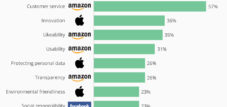Published on: April 3, 2025 / update from: April 3, 2025 - Author: Konrad Wolfenstein
America's economy in change: Tech-boom meets industrial crisis
Technological strength and industrial weakness in the USA: a comparative analysis
The economic structure of the United States shows a remarkable imbalance: While the technology sector, especially the IT industry, occupies a global management position, the industrial sector has clear weaknesses. This economic dichotomy not only shapes the US economy itself, but also significantly influences global trade relationships and business dynamics in Europe and Germany.
Suitable for:
- Technology trend – market for interactive screens in the USA: opportunities and potential for German companies
The dominance of the United States in the technology sector
The American technology sector has established itself as a driving force in the US economy and has a significant contribution to economic growth. In 2022, more than 10% of the total gross domestic product (GDP) of the United States accounted for the technology industry. With 12.2 million employees, the technology industry is an important employer-remarkable 7.9% of the entire US workforce are active in technology-related professions.
After a very successful year 2023, in which the technology-based NASDAQ index recorded a total amount of 45%, the above-average performance continued in 2024. In particular, the so -called “Magnificent Seven” - Alphabet, Amazon, Apple, Meta, Microsoft, Nvidia and Tesla - which, as the leading actors in the field of artificial intelligence, contributed significantly to this success.
Research and development focus in the high-tech area
A decisive factor for the dominance of the United States in the technology sector is its strong concentration on high -tech research and development. US companies focus their research and development mainly on high-tech industries, which make up 85% of private sector expenditure for research and development in the United States. In comparison, companies in the European Union invest approximately equally in high-tech and mid-tech industries, each of around 45% of total expenses.
This focus has led to impressive innovation dynamics. The research expenditure in the United States has quadrupled over the past two decades, while in the same period they have only doubled in the EU. The high investments in rapidly growing high technology areas are accompanied by an increasing economic gradient between the USA and the EU.
Innovative strength and future orientation
The United States has achieved a clear lead in important future fields such as IT services (social media, artificial intelligence), online trade and financial markets, especially among the decisive intangible assets. The proverbial American entrepreneurial spirit helps the United States better than many other countries shape and benefit from it.
In addition to the large technology giants, many other innovative companies thrive in the United States with promising business models. Examples are ServiceNow, a provider of cloud computing platforms, the share price of which has increased by over 50%, or Cadence, a specialist in development tools, whose share price rose by 38% in the same period. Many leading companies are also based in the USA in the area of cyber security, another growth market.
Suitable for:
The weaknesses of the US industry
Current situation of the processing trade
In contrast to the flourishing technology sector, the US industry shows significant weaknesses. The ISM index for the processing industry was 47.2 points in September and thus below the threshold of 50 points, which would signal an expansion. This means that industry continues to remain in the recession. The components of the index are particularly worrying: employment is 43.9 points, the new orders at 46.1 points, and the prices at 48.3 points.
These numbers indicate a continued structural weakness of the industrial sector, which is in clear contrast to the dynamics of the technology sector. The price development in industry shows an interesting anomaly: prices fall for the first time in a long time, which is a remarkable development in view of the general inflation.
Industrial recession and their effects
The industrial weakness in the USA has a variety of causes. The globalization of the supply chains has led to a shift in industrial production abroad, while focus on the service and technology sector has contributed to a relative neglect of the classic industry.
The markets are currently reacting strongly to geopolitical tensions, especially to reports on international conflicts and trade wars. Such uncertainties could further destabilize the economic situation and already have an impact on the market mood. The recent announcements in the United States to raise additional tariffs to imports from different countries have heavily contaminated the stock markets, especially in the technology sector.
Investment dynamics in the industrial sector
The industrial weakness is also reflected in investment development. While the USA in the areas of financial markets, IT services and online trading have won a clear lead, investments in the industrial sector have decreased. This underlines the relocation of the economic focus away from classic industry to technology and services.
However, there are also signs of a trend reversal: the United States has found answers to its interim investment weakness and, with the “Inflation Reduction Act”, gave a strong impulse for industrial investments. These measures aim to strengthen the United States industrial basis and to promote partial industrialization.
Recent developments and economic trends
Rein industrialization initiatives
The major expenditure programs are currently ensuring more stable industrial development in the USA: the Infrastructure Investment and Jobs Act (IIJA), Inflation Reduction Act (IRA) and the Chips and Science Act. These programs pump many billions of US dollars into the economic cycle and promote partial industrialization from the United States.
In the areas of solar technology, electromobility and semiconductors alone, according to industry associations, projects of almost $ 500 billion are located in the pipeline. At the same time, industrial areas that are not directly promoted also move back to their production to make the supply chains more robust.
Between 2021 and 2023, the value -based construction work of the processing industry nominal increased by a factor of 2.5 and in the first seven months of 2024 again increased by a quarter at the same period. According to Global Market Insights, the US market volume for manufacturing technology is to increase from almost 250 billion to $ 600 billion between 2023 and 2032.
Effects of the AI on the job market
The increasing use of artificial intelligence (AI) has a significant impact on the labor market in the IT sector in the United States. The unemployment rate in this area rose from 3.9% in December 2024 to 5.7% in January 2025, which is above the general average of 4%. This could be a sign that AI and automation jeopardize jobs.
An essential factor for this trend is the shift in the investments of large technology companies. Instead of creating new jobs, considerable means of building AI infrastructures flow. Routine tasks within IT, such as reporting and administrative activities, as well as increasingly the demand for programmers and system designers are particularly affected.
This development shows that even in the booming technology sector, structural changes take place that can lead to a shift in labor market dynamics and raise the question of whether AI ultimately becomes a “job killer”.
Current economic signals
The US economy currently shows mixed signals. While the labor market delivers surprisingly strong numbers, the industry remains in the recession. The latest Jolts data show that the number of open positions in the USA with 8.040 million is significantly higher than expectations, which indicates a persistently strong demand for workers.
At the same time, there are signs of significant economic cooling. The forecast model Gdpnow developed by the Atlanta Fed predicts a GDP change of -1.8% for the first quarter of 2025, with a “gold -adjusted” model forecasting growth of 0.2%. Experts expect a significant cooling compared to the previous quartals, with the risks for a recession increased.
Suitable for:
- What is the reason for the current success of some companies in mechanical engineering despite the economic crisis in Germany?
The comparison with Europe and Germany
Different specialization patterns
Compared to the United States, Europe and especially Germany show a significantly different specialization pattern in research and development. While 85% of US companies focus on high-tech industries, European companies invest in high-tech and mid-tech industries. In Germany, the proportion of mid-tech industries at 57% is even higher than in the EU average, while the high-tech content is only 36%.
This different specialization is also reflected in the development of labor productivity. The EU countries had caught up with the United States by the mid-1990s, but since then this trend has been reversed, and the EU falls behind the United States. This indicates that the concentration on high technology areas can lead to higher productivity increases in the long term.
Technological dependencies and trade relationships
The different specialization patterns lead to mutual dependencies in the trade relationships. The German deliveries of machines and plants to the USA rose by 19% to $ 37 billion in 2023, which underlines Germany's strength in this area.
At the same time, there is considerable dependence on the USA in the field of digital technologies in Germany. With digital technologies, hardly one way is going to the United States today, and eight out of ten German companies see themselves depending on the import of these technologies from the USA. Almost 90% of German companies import digital devices and services from the United States, while only 60% also export digital goods and services there.
This dependency is increasingly perceived as problematic. At 95%, almost every German company demands that Germany should become more independent of the USA when importing digital technologies and services. The new US presidency under Donald Trump brings additional unrest into the German economy, and every second company assumes that it is expected to change its supply chains by the Trump's election victory.
Conclusions and future prospects
The technological strength and industrial weakness of the United States not only shape the American economy, but also have a significant impact on the global economic order. The polarization between a dominant, innovative technology sector and a weakening, traditional industry is both challenges and opportunities.
The concentration on high technology areas has brought the United States impressive innovation dynamics and economic strength in these sectors. At the same time, however, they have lost ground in traditional branches of industries, which led to structural imbalances. With the current Rein industrialization initiatives, the United States is trying to counteract this imbalance and strengthen its industrial basis.
For Europe and especially Germany, the technological superiority of the USA is a challenge, especially in view of the existing dependencies in the field of digital technologies. The demand for more technological sovereignty shows that this dependency is increasingly perceived as a risk.
The current economic development, in particular the signs of economic cooling in the United States, could lead to shifts in global economic relationships. It remains to be seen how the Reinstustrialization efforts of the United States and the efforts of Europe will have an impact on longer -term economic development after more technological independence.
Both the United States and Europe are faced with the challenge of developing a balanced economic structure that includes both traditional branches of industry and modern technologies. The success of this task will significantly determine the future economic strength and resilience of these economic areas.
Suitable for:
Your global marketing and business development partner
☑️ Our business language is English or German
☑️ NEW: Correspondence in your national language!
I would be happy to serve you and my team as a personal advisor.
You can contact me by filling out the contact form or simply call me on +49 89 89 674 804 (Munich) . My email address is: wolfenstein ∂ xpert.digital
I'm looking forward to our joint project.















